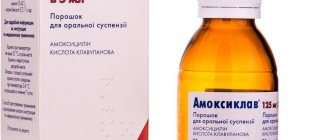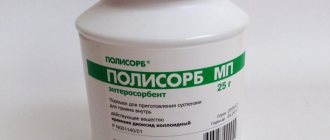6271
Author of the article
Evgeniy Nikolaevich Konoplev
Reading time: 9 minutes
AA
One of the effective broad-spectrum antibacterial drugs is Amoxiclav (Latin name - “Amoxiclav”). This drug is highly active against pathogens of many diseases. According to its chemical structure, Amoxiclav is a combination drug and combines a semi-synthetic penicillin drug with an inhibitor of bacterial protease enzymes.
Pharmacological properties and composition
According to the radar data, the active ingredients of the drug are Amoxicillin trihydrate and the potassium salt of clavulanic acid. In addition to the active ingredients, the composition includes excipients.
Several forms of Amoxiclav are available for sale:
- Enteric-coated tablets, INN - Amoxicillin + clavulanic acid . Each package contains 15 octagonal oblong white tablets.
- Amoxiclav 2X - white oval tablets containing 125 mg of acid and 500 or 875 mg of antibiotic, 14 and 10 pieces per pack.
- Amoxiclav Quiktab - dispersed tablets, 10 pieces per pack.
- Suspension for oral administration . In 1 bottle the amount of powder corresponds to 100 ml of suspension.
- Powder for making a solution that is administered intravenously. The bottles are packaged in packs of 5 pieces.
Amoxicillin is a penicillin antibiotic that has a bactericidal effect (kills microbial cells). The destruction of bacteria occurs due to interference in the synthesis of cell wall proteins. Some types of microorganisms have developed resistance to the drug due to the synthesis of the enzyme beta-lactamase. The drug contains a component that suppresses the activity of beta-lactamase - clavulanic acid. This acid itself also has some antimicrobial activity.
According to the Vidal reference book, Amoxiclav is active against the following types of microorganisms:
- Gram-positive aerobic bacteria sensitive to the penicillin series - enterococci, corynebacteria, Staphylococcus aureus, listeria.
- Anaerobic gram-positive bacteria - clostridia, peptococci, peptostreptococci.
- Gram-negative aerobic microorganisms - Salmonella, Shigella, Vibrio cholerae, Helicobacter pylori, Neisseria, Pasteurella, Haemophilus influenzae, Escherichia, Klebsiella, Protea, Moraxella.
- Gram-negative anaerobic microbes - bacteroides.
Both active components of the drug are quickly absorbed from the gastrointestinal tract. The maximum amount of the drug accumulates in the blood after an hour. The drug is distributed throughout all tissues and biological fluids of the body. The components of the drug do not penetrate into the cerebrospinal fluid unless the patient has signs of inflammation of the meninges. A small amount of active substances penetrates the hematoplacental barrier and into breast milk. Only a small part of the drug binds to plasma proteins.
Amoxicillin is removed from the body without changing the chemical structure through the kidneys. Clavulanic acid is also excreted through the kidneys, but is partially metabolized. Small amounts of the drug may be excreted through the respiratory tract and intestines.
Price for Amoxiclav in pharmacies
The approximate price for Amoxiclav in the form of tablets with a dosage of 875 mg/125 mg is 401-436 rubles (the package contains 14 pieces), with a dosage of 500 mg/125 mg - 330-399 rubles (the package contains 15 pieces), with a dosage of 250 mg /125 mg ‒ 170‒241 rubles (package contains 15 pieces). Powder for preparing an oral suspension with a dosage of 400 mg/57 mg can be purchased for approximately 158-273 rubles, a dosage of 250 mg/62.5 mg - for 212-299 rubles, a dosage of 125 mg/31.25 mg - 99-123 rubles . Powder for preparing an injection solution with a dosage of 1000 mg/200 mg will cost about 675-862 rubles, with a dosage of 500 mg/100 mg - 465-490 rubles (packages contain 5 bottles).
Indications and contraindications
Amoxiclav is used to treat infectious diseases whose pathogens are sensitive to its active ingredients. Instructions for use Amoxiclav recommends using the product for the following diseases:
- Respiratory tract diseases of infectious origin - sore throat, tonsillitis (inflammation of the tonsils), pharyngitis, laryngitis, sinusitis, bronchitis, pneumonia.
- Inflammatory processes of bacterial etiology that affect the organs of the urinary system - bacterial pyelonephritis, cystitis, urethritis, prostatitis in men.
- Purulent-inflammatory lesions of the genital organs in women are abscesses in the uterine cavity or pelvic tissue that form after childbirth.
- Infectious lesions of the abdominal organs.
- Purulent inflammatory diseases of the skin and subcutaneous fat - boils, carbuncles, infectious complications from burns, frostbite, after surgery.
- Odontogenic infections that arise as a complication of diseases of the teeth and jaws.
- Infectious lesions of the musculoskeletal system - osteomyelitis, bacterial arthritis.
In addition, the drug is prescribed for prophylactic purposes during surgical interventions and other invasive medical procedures.
The instructions for use of the drug Amoxiclav provide a list of contraindications for the use of this drug. These include the following diseases and conditions:
- Individual intolerance to the drug or its individual components.
- Intolerance to betalactam antibiotics - penicillins, cephalosporins, etc.
- Liver dysfunction while taking betalactam antibiotics.
- Infectious mononucleosis.
- Lymphocytic leukemia.
There are also conditions in which the drug can be prescribed with extreme caution. This list includes:
- diseases of the digestive system;
- acute and chronic liver failure;
- previous pseudomembranous colitis;
- renal dysfunction;
- simultaneous administration of anticoagulants.
pharmachologic effect
The semi-synthetic antibiotic Amoxiclav 500 mg + 125 mg has a wide spectrum of action, covering gram-positive/gram-negative microorganisms, thanks to the combination of two active substances:
- Amoxicillin is destroyed by beta-lactamases, which makes it inactive against microorganisms that produce this enzyme.
- Clavulanic acid is a substance related to penicillins. Has the ability to suppress the action of beta-lactamases. Protects amoxicillin from destruction by enzymes and expands its antibacterial spectrum.
The effectiveness of the combination of amoxicillin with clavulanic acid has been laboratory confirmed for:
- streptococci;
- staphylococci;
- shigella;
- Klebsiella;
- Brucella;
- echinococcus;
- Helicobacter;
- clostridium;
- Haemophilus influenzae;
- salmonella;
- protea
Bacteria resistant to the effects of Amoxiclav 500 mg + 125 mg:
- enterobacter;
- pseudomonas;
- chlamydia;
- mycoplasma;
- legionella;
- Yersinia.
Side effects
When taking Amoxiclav, undesirable reactions from various organs and systems are possible. All these effects are classified by frequency of occurrence. The most commonly observed:
- Gastrointestinal disorders - nausea, diarrhea, colitis, stomatitis, gastritis.
- Disorders of the liver and biliary tract - increased levels of ALT and AST, alkaline phosphatase and bilirubin, hepatitis, jaundice.
- Allergic reactions.
- From the blood system - leukopenia, thrombocytopenia, agranulocytosis, anemia, eosinophilia, thrombocytosis.
- Neurological and mental disorders - headache, dizziness, convulsions, anxiety, agitation, sleep disorders, behavioral disorders.
- Skin lesions - toxic epidermal necrolysis, exudative erythema, candidiasis of the skin and mucous membranes, Stevens-Johnson syndrome.
- In the kidneys, interstitial nephritis rarely develops.
In case of overdose, there were no cases described that threatened the patient's life or resulted in death. The following disorders may develop:
- abdominal pain, vomiting and diarrhea;
- violation of water-salt balance;
- development of crystalluria;
- convulsive syndrome.
A patient who has received an excessively high dose of the drug should be hospitalized in the intensive care unit and be under constant observation.
If the drug was administered less than 4 hours ago, gastric lavage is done and intestinal sorbents are given. With a longer time interval, Amoxiclav is removed from the body using hemodialysis.
Overdose
There are no reports of death or life-threatening side effects due to an overdose of Amoxiclav 500 mg + 125 mg. Reviews about the drug also do not contain information about irreversible health problems.
An overdose is manifested by gastrointestinal disorders, stomach pain, diarrhea, vomiting, and water-electrolyte imbalance.
There have been reports of isolated cases of crystalluria caused by taking amoxicillin, which led to the development of renal failure. Convulsions are possible.
In case of overdose of the drug, it is recommended to lavage the stomach, take adsorbents (activated carbon), and, if indicated, hemodialysis. The patient should be under medical supervision, treatment is symptomatic.
Directions for use and dosage
The drug Amoxiclav should be prescribed taking into account the maximum permissible dosage.
Before prescribing treatment with Amoxiclav to a patient, it is necessary to clarify whether there has been a history of allergic reactions to antibiotics from the group of penicillins or cephalosporins. If the answer is positive, the patient may develop cross-allergic reactions. To minimize the risk of side effects from the digestive system, it is recommended to take the tablets with meals.
If a patient develops a microflora resistant to Amoxicillin, a superinfection may form. In this case, adjustment of antibacterial therapy is required taking into account the results of microflora culture and sensitivity to antibiotics.
If a patient develops antibiotic-associated colitis, use of the drug should be discontinued immediately. Under no circumstances should such patients be prescribed medications that slow down intestinal motility. In rare cases, patients may develop crystalluria while taking an antibiotic. To avoid this, you need to drink enough liquid per day.
When conducting laboratory tests, an antibiotic can distort the results, giving a false positive reaction for the presence of glucose in the urine. Such results are possible if the reaction is carried out with Fehling's solution or Benedict's reagent. To clarify diagnostic data, it is necessary to conduct a urine test with glucosidase. Clavulanic acid in some cases gives false-positive results with the Coombs test.
If the patient develops side effects from the central nervous system, during treatment you should stop driving vehicles or working with complex mechanisms and assemblies that require increased concentration.
Injection
The injection solution may only be administered intravenously by stream or drip. 600 mg of the drug must be diluted in 10 ml of water for injection. The medicine should be administered very slowly - at least 3 minutes. The duration of the drip infusion of the drug is 30−40 minutes. Under no circumstances should the drug be frozen. Intravenous injections are prescribed to patients before surgery at a dosage of 1200 mg.
Pills
Amoxiclav tablets are allowed to be taken orally by adults and children over 12 years of age whose body weight exceeds 40 kg. Dosage:
- For mild or moderate infectious lesions, 375 mg of the drug is prescribed three times a day. An alternative treatment regimen is to take 625 mg of the drug twice a day.
- For severe lesions, 625 mg of the drug is prescribed every 8 hours or 1000 mg with a break between doses of 12 hours. The exact regimen and duration are determined by the attending physician individually for each patient.
- Patients with odontogenic infectious diseases are prescribed 375 mg of the drug three times a day or 625 mg twice a day for 5 days.
For patients with moderate renal failure, the dosage is reduced to 625 mg 2 times a day, and in case of severe failure, the interval between doses should be 24 hours.
Suspension
Amoxiclav suspension is used in pediatric practice. The dosage is selected taking into account the child’s body weight. In order to prepare the suspension, add 86 ml of water to the bottle and shake thoroughly. The package comes with a 5 ml measuring spoon.
For children during the first three months after birth, the suspension is prescribed at the rate of 30 mg/kg body weight per day. This amount of the drug is divided into 2-3 doses. After 3 months, the daily dosage is reduced to 25 mg/kg body weight and divided into 2 doses. For severe infections, the child is given the drug at the rate of 45 mg/kg body weight per day, dividing this dosage into 2 equal doses.
For elderly and elderly patients, dosage adjustment is required only if they have insufficient liver or kidney function.
Use during pregnancy and lactation
Experts conducted a number of experiments on laboratory animals. The study did not reveal any data on the effect of the drug on the condition of the embryo. The use of Amoxiclav for the treatment of pregnant women is permitted only in cases where the benefits of administering the medication outweigh the possible harm to the body of the mother and child.
When the drug passes into breast milk, it causes diarrhea, dysbacteriosis, and sensitization in infants. Therefore, while your wife is being treated with this antibiotic, you must stop breastfeeding.
special instructions
Taking Amoxiclav with meals reduces the likelihood of developing side effects from the gastrointestinal tract.
During course therapy it is necessary to monitor the functions of the liver, hematopoiesis and kidneys.
Against the background of severe renal dysfunction, the doctor must adjust the dosage regimen or increase the interval between taking the medication.
Impact on the ability to drive vehicles and complex mechanisms
If during treatment with the drug the patient is diagnosed with adverse reactions from the central nervous system (for example, convulsions or dizziness), it is recommended to refrain from driving vehicles and performing work that requires increased concentration and immediate psychomotor reactions.
Drug interactions
The simultaneous use of Amoxiclav with other drugs may affect the pharmacological properties of both the antibiotic and the drugs administered in parallel.
Variants of drug interactions:
- Absorption of the drug slows down when taken simultaneously with Glucosamine, antacids, aminoglycosides, and laxatives . With the introduction of vitamin C, the absorption of the antibiotic improves.
- An increase in concentration is observed with simultaneous treatment with amoxicillin and diuretics, anti-gout, non-steroidal anti-inflammatory drugs, calcium channel blockers.
- with anticoagulants with caution , as the prothrombin time increases.
- Amoxicillin and clavulanic acid increase the toxicity of methotrexate.
- Allopurinol, Disulfiram, Probenecid simultaneously with Amoxiclav
- Rifampicin , antibiotics from the group of macrolides, tetracyclines and sulfonamides, when administered simultaneously with amoxicillin, weaken each other's antimicrobial interaction.
- The use of Amoxiclav reduces the effectiveness of hormonal birth control pills for oral administration and can provoke breakthrough bleeding.
The abstract practically does not describe the compatibility of Amoxiclav and alcohol, although the drug causes a deterioration in the tolerability of the latter. As a result, the patient may develop serious poisoning. Possible development of anaphylactic shock, respiratory depression, cardiac dysfunction, nausea and vomiting. To avoid such complications, it is not recommended to drink alcohol within 48 hours after taking the antibiotic.
Use during pregnancy and lactation
During animal experiments, the harm of taking Amoxiclav during pregnancy and the effect of the drug on the embryonic development of the fetus were not confirmed. A single study of women with premature rupture of membranes found that prophylactic use of a combination of amoxicillin and clavulanic acid may increase the risk of necrotizing enterocolitis in newborns.
During pregnancy and lactation, the use of Amoxiclav is recommended only if the potential benefits of treatment for the mother significantly outweigh the possible risks to the health of the fetus and child. Clavulanic acid and amoxicillin are detected in small concentrations in breast milk. Breastfed infants may develop diarrhea, sensitization, and candidiasis of the oral mucosa; therefore, if treatment with the drug is necessary, it is advisable to stop breastfeeding.
Analogues and cost
The price of Amoxiclav in tablets can vary from 250 to 850 rubles. The price difference depends on the dosage and the manufacturing company. The cost of a bottle of powder for making a suspension ranges from 127 to 300 rubles.
The drug is dispensed at the pharmacy with a doctor's prescription.
According to reviews from practicing doctors, the most effective analogues of Amoxiclav are:
- Amoxicillin tablets 500 mg;
- Augmentin tablets;
- Amosin;
- Flemoxin Solutab;
- Suprax;
- Flemokav;
- Sumamed;
- Azithromycin.
For impaired renal function
Patients with moderate renal failure (creatinine clearance varies from 10 to 30 ml/min) are recommended to take Amoxiclav 1 tablet (dose 500 mg/125 mg or 250 mg/125 mg depending on the severity of the disease) every 12 hours, and severe renal failure (creatinine clearance is less than 10 ml/min) – 1 tablet (dose 500 mg/125 mg or 250 mg/125 mg depending on the severity of the disease) every 24 hours.
The first dose of solution for intravenous administration with CC 10–30 ml/min is 1000 mg/200 mg, then 500 mg/100 mg every 12 hours. When CC is less than 10 ml/min, the first dose of the solution for intravenous administration is 1000 mg/200 mg, then 500 mg/100 mg every 24 hours.
For anuria, the interval between doses of Amoxiclav is increased to 48 hours or more.
Reviews
Anatoly. In the spring I got sick with pharyngitis, and my doctor prescribed me to take the antibiotic Amoxiclav. The sore throat went away very quickly, but a complication developed in the form of intestinal inflammation. I still can’t get my intestines in order, although several months have passed.
Marina. I have been suffering from chronic sinusitis for many years. I tried many different antibiotics, Amoxiclav helps best. It's not too expensive. Other medications make me feel nauseous, but this one has no side effects. After being treated with it, I was able to do without surgery, so I am very pleased with the medicine.
Lukin M.V., surgeon. I often prescribe Amoxiclav to my patients. Very effective for infections of soft tissues and skin, especially streptoderma and erysipelas. Patients tolerate it well, except that occasionally allergic reactions occur.
© 2021 – 2021, Evgeniy Nikolaevich Konoplev. All rights reserved.
Composition of the drug
| Substance name | 2x 500mg + 125mg |
| Active substance: | |
| Amoxicillin trihydrate (equivalent to amoxicillin) | 500 mg |
| Potassium clavunate (equivalent to clavulanic acid) | 125 mg |
| Excipients: | |
| Crospovidone | 45 mg |
| Silica | 9 mg |
| Microcrystalline silicon-containing cellulose | up to 1060 mg |
| Magnesium stearate | 20 mg |
| Croscarmellose sodium | 35 mg |
| Film casing | |
| Hypromellose | 17.696 mg |
| Ethylcellulose | 0.864 mg |
| Polysorbate 80 | 0.96 mg |
| Triethyl citrate | 0.976 mg |
| Titanium dioxide | 9.36 mg |
| Talc | 2.144 mg |
Conditions of release and storage
The expiration date of the tablets can be seen not only on the packaging, but it will also be indicated directly on each blister or bottle of tablets.
Basically, Amoxiclav tablets can be stored for two years after release, after which it is recommended to dispose of the antibiotic.
It is also worth remembering that for normal storage conditions of antibiotics, as well as other dosage forms, it is recommended to keep the drug in a dark place inaccessible to children.
Attention! The very wide spectrum of antibacterial action of the drug, coupled with improper storage, can lead to serious complications. So, for example, storing Amoxiclav for 5 years may lead to a change in the pharmacological and pharmacokinetic properties of the drug.
In order for a patient to receive an antibiotic at a pharmacy, a prescription must be written out. It is also worth noting that a prescription is written in Latin for tablets and other medications, issued strictly as prescribed by a specialist.
Instructions
This medication is prescribed in different ways. The method of administration directly depends on the age of the patient, his weight, the severity of the infection, and in addition, on the condition of the liver and kidneys. The optimal time to take the drug is the beginning of a meal. How many days should I take Amoxiclav 875+125? The course of this medicine lasts from 5 to 14 days; it cannot be used longer.
How many times a day is Amoxiclav 875+125 taken? The tablets are taken every eight hours, that is, 4 times a day.
If it is necessary to use medication for the treatment of patients with kidney disease, the creatinine content in the urine must be taken into account. Patients with liver problems require constant monitoring of liver functions. This is confirmed by the instructions for use for Amoxiclav 875+125.
Which is better, suspension or tablets?
When choosing which is better Amoxiclav in the form of a suspension or tablets, the patient must first of all understand that these are exactly the same drugs, expressed in different forms and with different dosages of the main component.
It cannot be said, for example, that prescribing Amoxiclav in tablet form will be the best option for young children or pregnant women. This is primarily due to the fact that the dosage of amoxicillin in tablets will be significantly higher than in the suspension.
However, if the doctor prescribed Amoxiclav tablets to the baby, there had to be clear reasons for this - an acute infection or the inability of a small body to cope with the virus when using a weaker analogue.
Attention! The prescription of tablets is more suitable for the treatment of adults with moderate and severe forms of bacterial infections.
What are Amoxiclav tablets taken for?
Various infectious diseases in adults are becoming more numerous every year, as the bacteria that cause diseases progress and become more resistant. To understand why the patient is taking Amoxiclav tablets, it is necessary to study the indications for use. This antibiotic is prescribed in the following cases:
- For severe infectious diseases of the upper and lower respiratory tract. Amoxiclav will be used in the treatment of sore throat, bronchitis, pneumonia, otitis media, sinusitis, etc.
- In case of inflammatory processes in the kidneys, in this case you need to be treated with special care, since problems with the urinary system can create problems with removing the antibiotic from the body.
- For inflammation of tissues and joints, the action of the tablets promotes the healing process of wounds after operations and after bites.
- Helps with various diseases caused by microbes that react to penicillin.
Attention! Amoxiclav tablets have an antibacterial effect against a wide range of microbes, but only a specialist can prescribe the drug.
Using the product for sore throat
Antibiotics in the presence of sore throat are prescribed only in the case of the development of moderate or severe severity of this disease. Amoxiclav is often prescribed as an antibiotic for sore throats. Its use is indicated only when the bacterial form of infection is confirmed with the presence of pathogenic microflora, tested for sensitivity to the drug in question. When treating angina in children, suspensions are used, and tablets are used for adults. In severe situations, injections of the drug are used. It is important to remember that antibiotics should under no circumstances be used for a long time, as this increases the resistance of pathogenic microflora to them.










